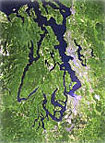
Puget Sound aerial photo
(Courtesy of Puget Sound Water Quality Action Team
http://www.wa.gov/puget_sound/)

|
The Puget Sound is a good example of a glacial fjord estuary. It is located in northern Washington State. There are more than 10,000 rivers and streams that drain into the Puget Sound. The freshwater comes from rivers such as the Nooksack, Skagit, Puyallup, Nisqually and Skokomish. The saltwater source is the Pacific Ocean. The Puget Sound is surrounded by more than 2,300 miles of shoreline, which includes, beaches, bluffs, mudflats, and wetlands. The Sound is made up of a series of underwater valleys and ridges that makes the Puget Sound a relatively deep estuary. The average depth of the Sound is 137 meters (450 feet) and the deepest point is 274 meters (900 feet) which occurs just north of Seattle.  Puget Sound satellite image (Courtesy of Puget Sound Water Quality Action Team http://www.wa.gov/puget_sound/) The Puget Sound consists of a diverse collection of habitats, there are more than 350 different species of fish, seabirds, marine mammals, invertebrates and plants. The Sound also plays an important economic role to the regions economy. Shipping and transportation, fishing and shellfishing, recreational activities and tourism are activities that help the economy. Seattle and Tacoma are the region's leading ports. The waterways are also transportation links for the coastal communities of the Sound. Fish and shellfish are valuable economic resources to the Puget Sound. Fishing and aquaculture industries rely on crabs, salmon, oysters, herring, cod and flounder that come from the Sound. Recreation and tourism are also important to the regions economy. The Sound provides many day trip activities including kayaking and recreational boating.
|